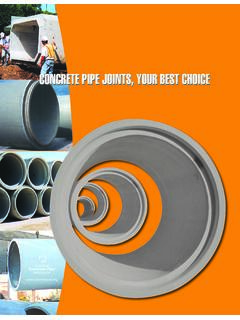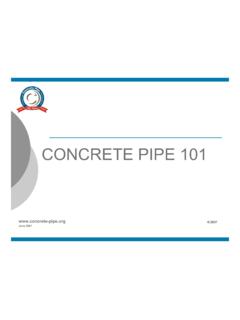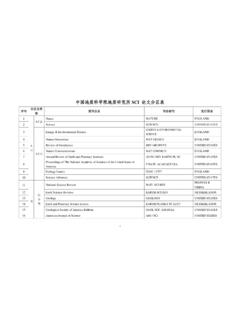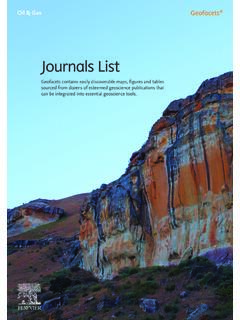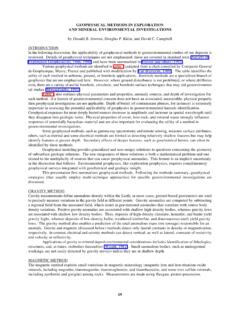Transcription of Aggregates for Use In Concrete
1 2/12/2015 1 Aggregates for Use In Concrete 2 Learning Objective Develop a basic understanding of Aggregates and aggregate properties. 2/12/2015 2 3 Aggregates Fine Consists of natural sand, manufactured sand or crushed stone <3/8 Fine aggregate will pass the # 4 sieve Coarse Natural or crushed stone 3/8 to 1 (or more) Coarse aggregate is larger than a #4 sieve 4 mineralogy Igneous (Latin - Fire ) Formed from volcanic processes and the heating and cooling of magma Example: granite sedimentary (Latin - Settling ) Formed by the layering of sediments due to the action of wind or water Example: sandstone Metamorphic (Greek - Change ) Result from long-term high temperature and pressure on igneous and sedimentary rocks Example: marble 2/12/2015 3 Mineral Composition Particle Shape Surface Characteristics Gradation Soundness Chemical Activity Physical Properties Specific Gravity Hardness Thermal Properties Absorption Elastic Properties Cement Solutions Deleterious Minerals Uniformity Flat Elongated Angular Round Stone Gravel Coatings Roughness Bond to Mortar Freezing and Thawing Workability and Water Requirement of Cement Cement Content Proportions Fine Coarse Salts Artificial Aggregate Maximum Size Toughness Wear Permeability Coarse Aggregate Mineral Composition Particle Shape Surface Characteristics Organic Impurities Gradation Soundness Chemical Activity Physical Properties Specific Gravity Hardness Thermal Properties Absorption Elastic Properties Cement Solutions Water Reten-tivity Deleterious Minerals Uniformity Flat Elongated Angular Round Manufac- tured Bond Natural Band Coatings Roughness Bond to Paste Freezing and
2 Thawing Workability and Water Requirement of Concrete Cement Content Proportions Fine Coarse Salt Fine Aggregate 2/12/2015 4 7 Aggregates Important Properties Durability, Freeze - Thaw and Chemical Resistance Hardness, Toughness, Abrasion Texture & Shape Strength Unit Weight / Density Cleanliness 8 Aggregate Specifications ASTM C33 - Normal Weight Aggregates ASTM C330 - Lightweight Aggregates ASTM C637 - Radiation Shielding Aggregates (Heavyweight) 2/12/2015 5 10 Aggregate Specifications ASTM C33 - Normal Weight Aggregates Durability requirements 2/12/2015 6 Deleterious Substances C 33 12 Deleterious Substances Lignite is sometimes found in natural sand. The amount varies, depending on the quarry and the particular deposit. When sand containing lignite is used in making Concrete , lignite particles near the surface can expand and cause the pop outs. Lignite is often referred to as brown coal, it is the lowest rank of coal quality.
3 Item Mass % of Total Sample Clay lumps and friable particles Material finer than 75 micron (No. 200) sieve: Concrete subject to abrasion * All other Concrete * Coal and lignite: Where surface appearance of Concrete is of importance All other Concrete Source: Table 1 Limits for Deleterious Substances in Fine Aggregate for Concrete , ASTM C 33. * In the case of manufactured sand, if the material finer than the 75-micron (No. 200) sieve consists of the dust or fracture, essentially free of clay or shale, these limits are permitted to be increased to 5 and 7%, respectively. 2/12/2015 7 Deleterious Substances C 33 Organic Impurities C 40 (fine aggregate) Sodium Hydroxide Solution What is the effect on Concrete if negative result?
4 2/12/2015 8 15 Larger Aggregate Test Check for silt or clay Mason jar test is not official test, but only an indication of how much fine material is present. Check ASTM C33 and FDOT Sections 901 and 902 for amount and type of allowable fine material. Use a Mason jar 16 Durability of ASTM C 88 2/12/2015 9 17 Soundness Resistance to weathering action Standard Test ASTM C 88, Sodium or Magnesium Sulfate Soundness Intended to simulate wet/dry and freezing/thawing conditions Reproducibility of results is sometimes difficult 18 Soundness Test consists of 5 cycles of soaking in sulfate solution followed by the 5 cycles any breakdown of the aggregate is removed and the loss in weight calculated. This value is reported as the Soundness Loss Typical Specification Limits are between 8-18% depending on which salt is used Magnesium salt gives higher losses than Sodium 2/12/2015 10 19 Abrasion Test Purpose To evaluate the aggregate s resistance to degradation during processing, mixing, placing, and later while in service Standard Test Methods ASTM C 131 ( Aggregates < 1-1/2 ) ASTM C 535 (larger Aggregates ) ASTM C33 50% maximum loss 100 initialfinalinitialWWWLoss20 Aggregate Specifications ASTM C33 - Normal Weight Aggregates Size and Gradation 2/12/2015 11 Always read Materials section of an ASTM 22 Aggregate Size Maximum Size: The smallest sieve opening through which the entire amount of aggregate is required to pass.
5 Nominal Maximum Size: The smallest sieve opening through which the entire amount of aggregate is permitted to pass. Example: ASTM C33 requires that 100% of a # 57 coarse aggregate MUST pass the sieve but 95 - 100% MAY pass the 1 sieve, therefore # 57 aggregate is considered to have a Maximum size of and an Nominal Maximum size of 1 . 2/12/2015 12 23 Aggregate Gradation Also known as sieve analysis It is the distribution of particle sizes Well-graded Aggregates : particles evenly distributed among sieve sizes require less cement and water than poorly graded Aggregates Careful choice of Aggregates provides for optimization of cement, water and admixtures Most Common Sieve Series Sieve Size 1-1/2 1 3/4 1/2 3/8 #4 #8 #16 #30 #50 #100 #200 Metric Size 38 mm 25 mm 20 mm mm 10 mm mm mm mm mm mm mm mm International mm --- 19 mm --- mm mm mm mm mm mm mm mm Not used in FM Calculation 2/12/2015 13 25 Aggregate Size Effects: As the maximum size aggregate increases, the amount of paste needed for a given slump decreases.
6 The maximum aggregate size used in a Concrete mix is dictated by the size of the structural member and the spacing between reinforcing steel. Design & Control of Concrete Mixtures, 14th Edition, Portland Cement Association. Sand Stone Well Graded Blend Graded Aggregate 2/12/2015 14 27 Gradation Distribution of particle sizes Grading is determined by ASTM C 136 Well graded Concrete Aggregates will result in fewer voids between particles = less cement paste demand 28 Aggregate Gradation Affects: Workability Pumpability Economy Porosity Shrinkage Durability 2/12/2015 15 29 Fineness Modulus (FM) A single number system used to express the fineness or coarseness of an aggregate Higher values indicate coarser grading Sum of cumulative % retained on the standard sieves Certain sieves are NOT counted (even if used) Can be helpful in calculating blends of two materials FM of coarse aggregate can also be calculated and can aid in blending coarse and medium size materials FM & Gradation are NOT the SAME 30 Fine Aggregate Gradation Fineness Modulus (FM) should be between and FM is empirical # determined by dividing the sum of percent retained on a standard series of sieves by 100 (No.)
7 4, 8, 16, 30, 50, 100) Coarser fine aggregate has a higher FM Sieve Percent Passing 3/8 in 100 No. 4 95-100 No. 8 80-100 No. 16 50-85 No. 30 25-60 No. 50 5-30 No. 100 0-10 ASTM C 33 Grading for Fine Agg 2/12/2015 16 31 Percent Passing the No. 200 Sieve Very fine material such as silt, clay, or dust of fracture can increase the water demand in Concrete Fines limit is 3% in ASTM C 33 for Concrete subject to abrasion Manufactured sands 5% and 7% Coarse aggregate limit is 1% ( for crushed stone) 32 Gradation & Fineness Modulus: Dry Sample Wt. g Sample: Retained Sieve Size, (mm) Sieve Size, (US) Mass, (g) Ind. % Retained Cum % Retained % Passing 150 1 1/2" 75 1" 3/4" 19 1/2" 3/8 # 4 # 8 #16 # 30 # 50 # 100 Pan Pan Total Sieve Loss Check 2/12/2015 17 33 Dry Sample Wt.
8 1267 g Sample: Retained Sieve Size, (mm) Sieve Size, (US) Mass, (g) Ind. % Retained Cum % Retained % Passing 150 1 1/2" 0 75 1" 0 3/4" 0 19 1/2" 0 3/8 0 # 4 25 # 8 163 #16 228 # 30 278 # 50 355 # 100 177 Pan Pan 38 Total 1264 Sieve Loss Check Gradation & Fineness Modulus: ASTM 136 If the amounts differ by more than ,based on the original dry sample mass, results should not be used. (1267-1264) / 1267 x 100 = Dry Sample Wt. 1267 g Sample: Retained Sieve Size, (mm) Sieve Size, (US) Mass, (g) Ind. % Retained Cum % Retained % Passing 150 1 1/2" 0 0 75 1" 0 0 3/4" 0 0 19 1/2" 0 0 3/8 0 0 # 4 25 # 8 163 #16 228 # 30 278 # 50 355 # 100 177 Pan Pan 38 Total 1264 100 Sieve Loss Check Gradation & Fineness Modulus: (163 / 1267) x 100 = (25 / 1267) x 100 = Use original dry mass 2/12/2015 18 Dry Sample Wt.
9 1267 g Sample: Retained Sieve Size, (mm) Sieve Size, (US) Mass, (g) Ind. % Retained Cum % Retained % Passing 150 1 1/2" 0 0 0 75 1" 0 0 0 3/4" 0 0 0 19 1/2" 0 0 0 3/8 0 0 0 # 4 25 # 8 163 #16 228 # 30 278 # 50 355 # 100 177 Pan Pan 38 Total 1264 100 FM Sieve Loss Check Gradation & Fineness Modulus: 1 & 1/2 sieve are NOT used to calculate FM Never include the Pan when calculating the FM Cum% retained/100 Dry Sample Wt. 1267 g Sample: Retained Sieve Size, (mm) Sieve Size, (US) Mass, (g) Ind. % Retained Cum % Retained % Passing 150 1 1/2" 0 0 0 100 75 1" 0 0 0 100 3/4" 0 0 0 100 19 1/2" 0 0 0 100 3/8 0 0 0 100 # 4 25 # 8 163 #16 228 # 30 278 # 50 355 # 100 177 Pan Pan 38 Total 1264 100 FM Sieve Loss Check Gradation & Fineness Modulus: 100 - 2 = 98 100 - = 2/12/2015 19 Gradation & Fineness Modulus: Can you use this SAND to manufacture Pipe under C76?
10 Dry Sample Wt. 1267 g Sample: Retained Sieve Size, (mm) Sieve Size, (US) Mass, (g) Ind. % Retained Cum % Retained % Passing ASTM C33 Fine Aggregate Min Max 150 1 1/2" 0 0 0 100 100 100 75 1" 0 0 0 100 100 100 3/4" 0 0 0 100 100 100 19 1/2" 0 0 0 100 100 100 3/8 0 0 0 100 100 100 # 4 25 95 100 # 8 163 80 100 #16 228 50 85 # 30 278 25 60 # 50 355 5 30 # 100 177 0 10 Pan Pan 38 Total 1264 100 FM FM FM Sieve Loss Check ASTM C 33 - 90 3/8# 4# 8# 16# 30# 50# 100 Sieve SizePercent PassingFM = 20 Percent Retained 3/8# 4# 8# 16# 30# 50# 100 PanSieve SizePercent RetainedFM = High Fineness Modulus: Dry Sample Wt. 1091 g Sample: Retained Sieve Size, (mm) Sieve Size, (US) Mass, (g) Ind. % Retained Cum % Retained % Passing ASTM C33 Fine Aggregate Min Max 150 1 1/2" 0 0 0 100 100 100 75 1" 0 0 0 100 100 100 3/4" 0 0 0 100 100 100 19 1/2" 0 0 0 100 100 100 3/8 0 0 0 100 100 100 # 4 90 95 100 # 8 251 80 100 #16 230 50 85 # 30 190 30 25 60 # 50 240 5 30 # 100 77 0 10 Pan Pan 10 Total 1088 100 FM FM Sieve Loss Check 2/12/2015 21 # 4# 8# 16# 30# 50# 100 Percent PassingSieve SizeASTM C 33 - 90 FMDesign and Control of Concrete Mixtures, 14th Edition, Portland Cement Association.



